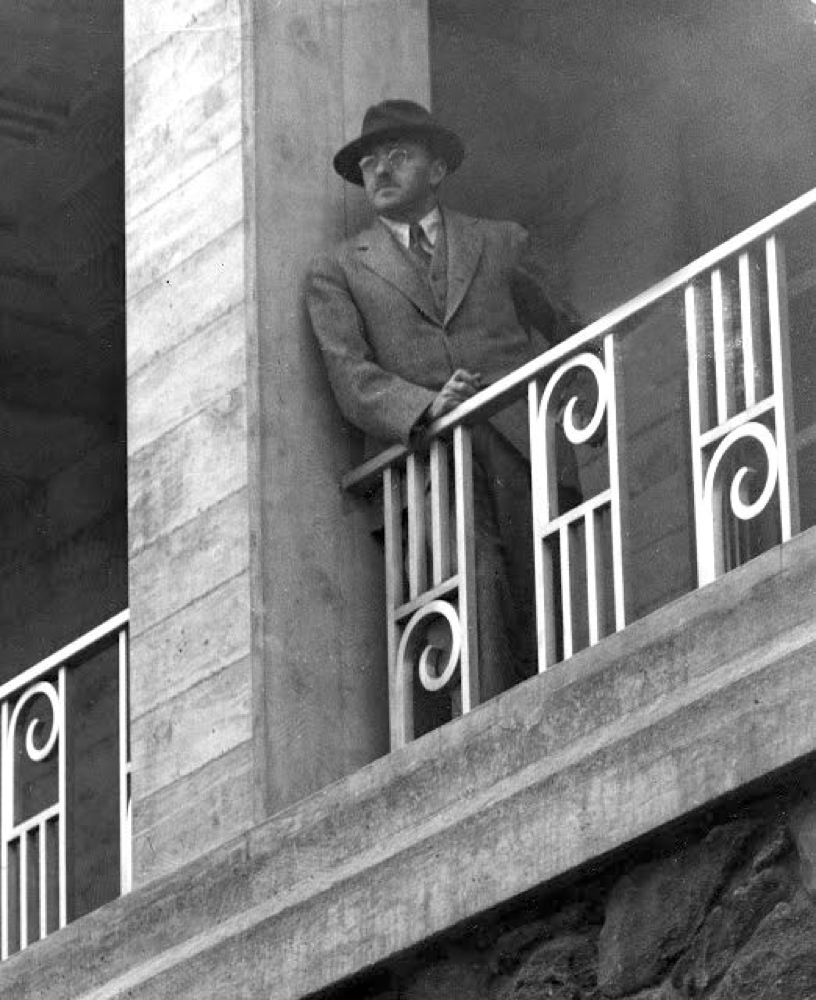A reflection on John Gaw Meem by his grandson and educator Nicholas Wirth
For millennia, the deserts, plains, and high mountains of New Mexico were impacted by cross-cultural currents that merged to form a unique and diverse human landscape. Centuries past as indigenous peoples built sophisticated, interconnected cultures and empires that spanned vast spaces. The region provided a cornucopia of resources as well as hardship. When the Spanish arrived in the 16th century, with their Eurocentric cultural perspectives, they radically and forcefully transformed the built landscape. In 1609, Spain established its northern, North American capital in Santa Fe, signaling the birth of a new multicultural experiment. In the early 19th Century, the Santa Fe Trail was opened and a flood of new peoples, products, and ideas came rushing into the Southwest. A hasty preemptive war ushered in yet another change when the Southwest was brought into a new republic in 1848. With a compromise in 1850, New Mexico was organized into a territory. Statehood followed in 1912, signaling the beginning of a new phase. Throughout it all, New Mexicans were etched by a set of truly unique experiences, indelibly setting the stage for the modern era. John Meem arrived in Santa Fe in 1920 and was captivated by this history and the mixture of peoples and cultures in New Mexico. He was one of a handful of regional architects who preserved and transformed the mid-twentieth-century American landscape.
Meem was born in Pelotas, Brazil in 1894. His father helped found the Brazilian Anglican Communion and oversaw the construction of a formative Episcopal Church in 1908. He preached to his flock in Portuguese and spread the Anglican doctrine throughout southern Brazil. Being exposed to different cultures and languages, left an indelible mark on a young Meem. Perhaps his open-mindedness and acceptance of other cultures came from his early experiences in the Southern Hemisphere. However, following the family tradition, at the age of 16, he was sent from Rio de Janeiro to attend the Virginia Military Institute. VMI was a dark chapter in Meem’s life. He was brutally hazed because of his accent, age, slight stature, and demeanor. He graduated in 1914 with a degree in civil engineering. His experiences at the draconian Virginia institution inspired a yearning for classical education, a feeling that would stay with him for the rest of his life. He moved to Brooklyn, New York, and worked for his uncle expanding the subterranean subway system.
As the world devolved into the grips of WWI, the Army called up Reservist Lieutenant Meem, sending him to Aimes, Iowa, to train enlisted men bound for the European theatre. A year later, while serving in the Long Island National Guard he contracted the H1N1 virus, or Spanish Flu, which infected nearly one-third of the global population and killed over 50 million souls. After recovering, he left the Army and took a job with the National City Bank of New York. Meem spoke fluent Portuguese and was sent to Rio de Janeiro. Unfortunately, due to his weakened immune system, he quickly succumbed to tuberculosis, the disease that would redefine his life. He returned to New York to seek treatment.
His physician recommended the prevailing treatment for T.B. - recuperation in one of the many sanitoriums located in the clean air that dotted the United States. Meem traveled west on the storied Atchison, Topeka and Santa Fe Railroad and arrived at the Sunmount Sanatorium, situated at the bottom of Monte Sol in Santa Fe, New Mexico in 1920. The hospital was ideally located in the arid high alpine desert. Dr. Frank Mera, who ran the hospital, was committed to not only rehabilitating the body but also stimulating the mind. Patients took brief walks, followed by long periods of rest on “sleeping porches”, attempting to abate pulmonary inflammation. Mera also exposed his clients to diverse regional cultural traditions through a program of national and locally renowned speakers. He took his patients on field trips, where they visited Franciscan missions, old colonial villages, and the great pueblos around New Mexico. One experience left a lasting mark on Meem. In 1921, he visited the dilapidated San Jose de Garcia Church in Trampas. He was struck by the significance the building played in the small Northern New Mexico village. In so many ways, the crumbling edifice was the glue that held the community together. Losing the church would be devastating to Trampas, and reaching back to familiar familial themes that were formed in Pelotas, Brazil, Meem volunteered with a group called Preservation and Restoration of New Mexico Mission Churches. Through his efforts, he also researched the history and materials of buildings across the state. He explored existing architectural styles and his own aesthetic began to form. Meem wrote, “The point here is that I became a regional architect and began to look for new precedents here in Santa Fe. The newly constructed Fine Arts Building of the Museum of New Mexico, built in 1917 in the Spanish-Pueblo style in permanent materials, inspired me greatly.” (Meem in Chile Club Papers: 168) It was through these experiences, and many others, that Meem gained a true appreciation for the interplay between the Puebloan and Spanish Territorial traditions and vernacular and ecclesiastical architecture around the Southwest.
After recuperating at Sunmount, Meem understood that he needed to hone his drafting and engineering skills and took a job as a draftsman for the preeminent architect, Bernham Hoyt, in Denver. There he studied classical proportion and practiced the Beaux-Arts style of architecture and Meem assisted on several projects throughout the city. However, a tubercular relapse cut his time short in Colorado and he once again found himself in Dr. Mera’s care in 1923.
Fortunately, the Sunmount routine and high alpine air worked its magic again, ushering a complete recovery. Dr. Mera encouraged Meem to stay on at one of the Sunmount cottages and dig into their shared passion for historic preservation. It was there, in 1923, that his architectural career began to take off. Meen designed buildings for friends and former patients and continued his work with the Society for Preservation and Restoration of New Mexico Churches. In the 1920s, the young architect spent much of his time working at Acoma Pueblo in western New Mexico restoring their church, San Esteban del Rey. These experiences once again reinforced his appreciation for vernacular architecture and influenced his interpretation of the built environment.
John Meem began building his architectural office, combined with his residence, in the late 1920s on Camino del Monte Sol. Construction was finished in 1930, across a field from Sunmount, and it was there that so many significant public buildings and private homes were envisioned. In 1928, he remodeled the old Exchange hotel on the Plaza, continuing in the Pueblo Revival tradition that was established earlier in the century. He played with Pueblo and Territorial styles while embracing modern architectural materials. The newly renamed La Fonda Hotel won widespread accolades. This was only the beginning of a long and storied career.
Meem would go on to envision and build some of the most iconic structures in the Southwest. Touching on his deeply held passion for classical education, he designed some forty buildings at the University of New Mexico, including his iconic Zimmerman Library. His unique vision - celebrating historical roots while embracing the future - are clearly evident at the Colorado Springs Fine Arts Center. According to the National Register of Historic Places nomination, “Its monolithic pueblo massing, its undisguised modern use of concrete, aluminum and glass; its southwestern details, its Native American designs abstracted into Art Deco ornamentation; its streamlined elegance; and its classical proportions - all result in a timeless character - with fundamental roots to the region and the time as well as manifesting an innovative architectural reflection of the building's underlying function, which is to preserve culture and to honor the contemporary.”(Nomination Form: 3) He embraced the Santa Fe community, building Cristo Rey Church, with help from many of its parishioners. The project required making nearly 200,000 adobe bricks. The building provided a permanent home for the sacred Reredos of Our Lady of Light. Meem’s extraordinary talent for attention to detail and deep understanding of the importance and longevity of the built environment were perennial themes in his work.
John Meem designed many significant buildings throughout the region over four decades and exerted an undeniable legacy on historic preservation. Simply put, New Mexico would be a distinctly different place if Meem had chosen to recuperate in Asheville, NC instead of at Sunmount in Santa Fe. His vision continues to have an ongoing deep impact on our community. However, perhaps most importantly, John Meem was a gentle soul and widely respected for his kindness. He was a can-do man who was equally comfortable dreaming of great buildings, paying respect to ancient traditions, or just sweeping up at the end of the day. Long after his death, Gene Ortega, a local Santa Fean who helped maintain Meem’s office in the 50s, told me how much he respected my grandfather not only as a great architect but also as a man who was willing to help anyone in need. John Meem was an inclusive, energetic, and intuitive man who left an indelible mark on the Southwest. We are blessed that he chose to make his mark in Santa Fe over 100 years ago. Now it's up to the community, that Meem so cherished, to carry on his respect for the past and his vision for the future.
Nicholas Wirth
6/17/20
(Written on my father’s 84th birthday)






